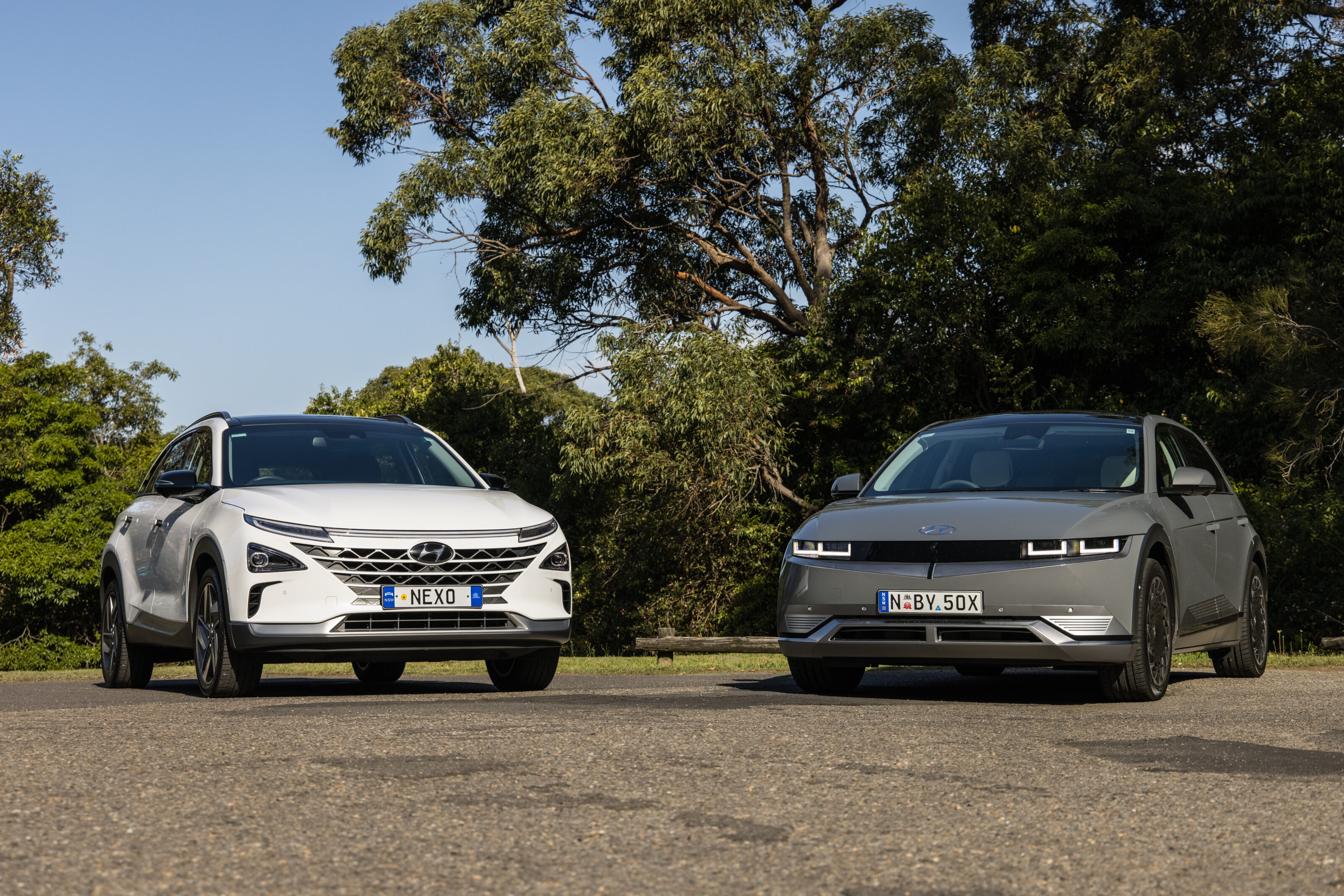This is an unusual – and unusually interesting – twin test. Pitting two cars against each other is routine. Likewise, taking from the same manufacturer isn’t unheard of on these pages, but it’s not a regular event.
There are, however, few companies from which we can take two cars that represent two different approaches to the future of electromobility.
Hyundai, as you may be aware, has just released the new IONIQ 5 battery electric vehicle. With a maximum WLTP-certified driving range of 451 kilometres, it looks like a hatchback – but with the space of a medium to large SUV.
Starting at $69,000, it’s not cheap, but it’s not expensive either. It’s rare, though, with no more than 400 available in the next six months – and the first 240 went within two hours of going on sale.
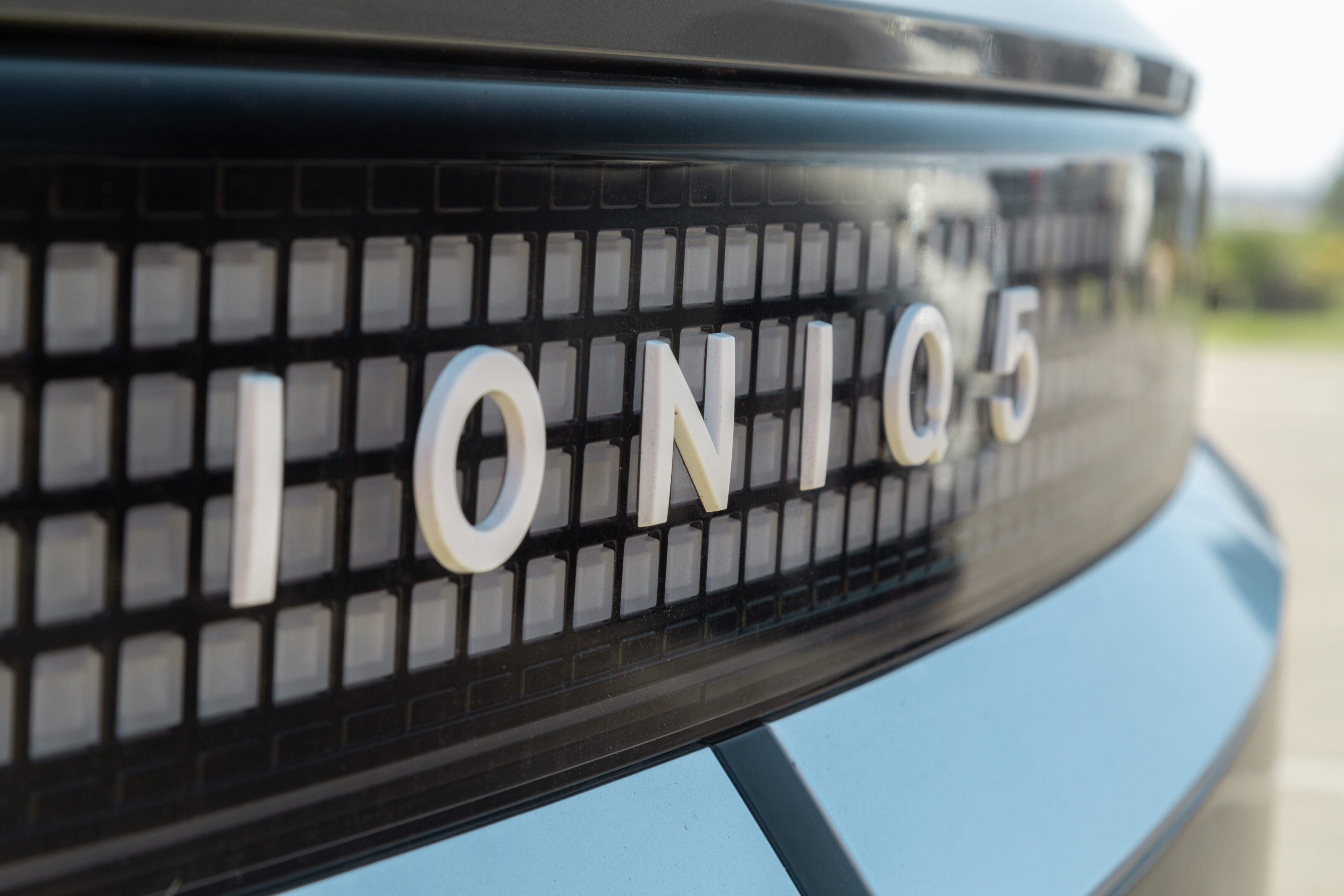
Slightly more exclusive – and rather more expensive – is Hyundai’s Nexo. As a second-generation follow-up to the ix35 FCEV, Hyundai’s hydrogen fuel cell SUV is the other side of the company’s EV coin.
In Australia, you can’t buy one unless you’re a government or big fleet business with the ability to install a hydrogen filling station.
It’s still a low-volume seller by Hyundai standards, shifting 10,000 units since its introduction into the Korean market in 2019. It has one clear advantage over the IONIQ 5, though – it will always be faster to fill and get going again, as long as the infrastructure is there.
Why are we comparing the Nexo and IONIQ 5?
This is less a battle between two cars in the same segment or price point, and more a comparison of what’s to come – from not just Hyundai, but from manufacturers all over the world.
Hydrogen may not be treated to the same fanfare day-to-day as the more common battery-electric vehicles on the market, but make no mistake – this is very much a ‘who dares, wins’ moment in automotive history.
Pricing and Features
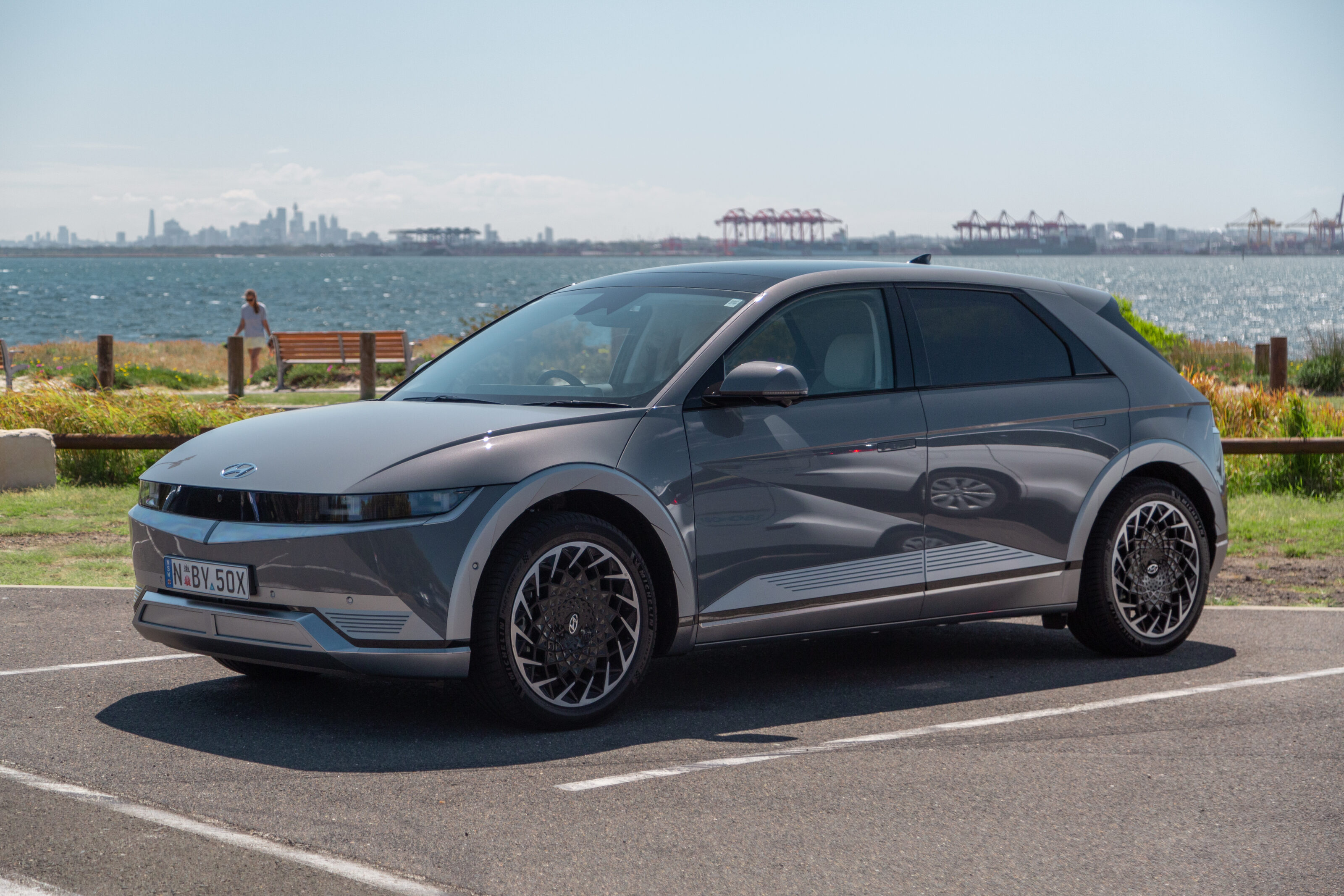
The IONIQ 5 has so far been made available only in a Launch Edition spec, with a choice of rear wheel drive and all-wheel drive.
How many driven wheels you choose will dictate its maximum range and how quickly it will cover ground. the rear-wheel drive can eke out 451km on a charge while the all-wheel drive manages 430km. The AWD’s 0-100km/h time, however, is 2.2 seconds faster than the RWD, at 5.2 seconds.
The price difference is $4000, with the RWD starting at $71,900 and the AWD at $75,900.
Before you ask “who’s paying over seventy grand for a Hyundai?”, may I point you to a lot of Palisade buyers, and the crashed website the day the IONIQ’s first allocation was released.
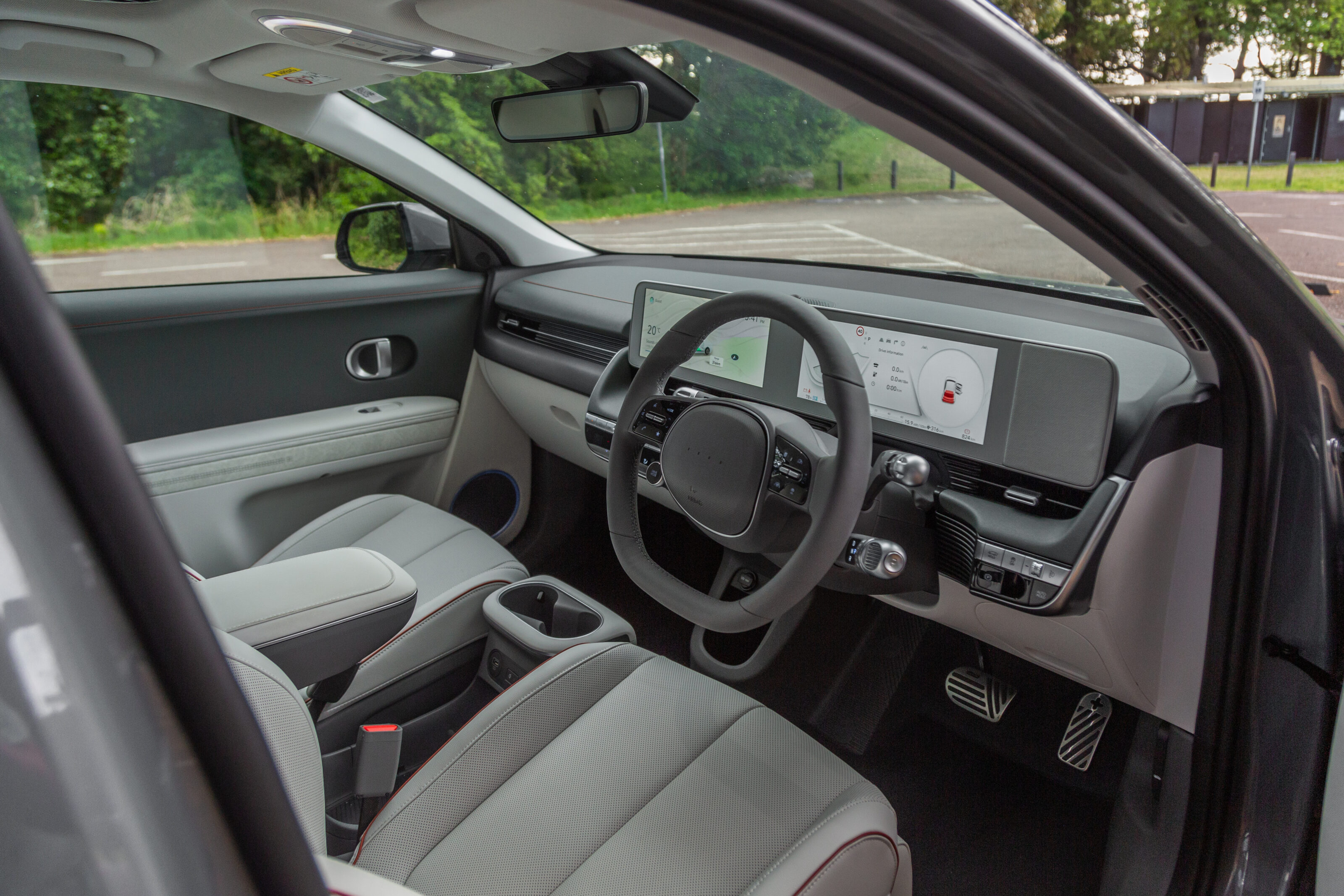
Onboard the 5 you’ll find those polarising 20-inch wheels, LED headlights, flush-fitting door handles, keyless entry and start, leather interior, dual-screen dash and media system, both measuring a Mercedes MBUX-like 12.3-inches, heated steering wheel, huge glass sunroof, powered and heated front seats, heated steering wheel, eight speaker BOSE-branded stereo and dual-zone climate control.
The hefty safety package includes blind-spot collision avoidance assist, blind-spot view monitor, driver attention warning, lane-keep assist, rear parking collision avoidance, front and rear parking sensors, rear cross-traffic collision avoidance (ie reverse AEB), rear occupant alert, safe exit assist, active cruise control with stop and go and machine learning and around-view cameras.
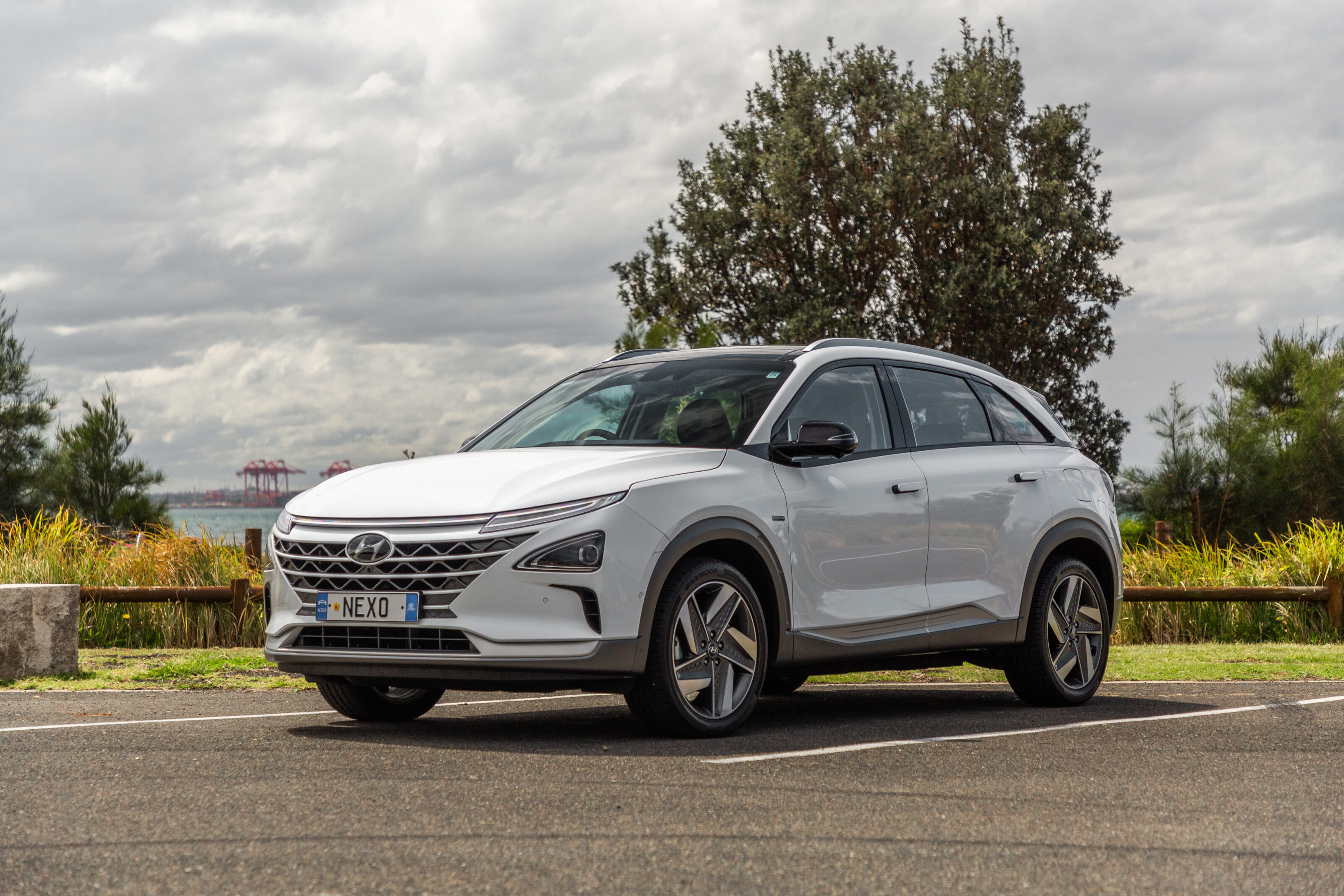
The Nexo’s more familiar-looking SUV body comes with 19-inch alloys, LED headlights, around view cameras, remote parking assist, fake leather interior, panoramic glass sunroof, eight speaker Krell-branded stereo system, powered tailgate, dual-zone climate control, heated and ventilated electrically-operated front seats and heated rear seats.
The battery takes up all the space under the boot floor, so you get a tyre repair kit instead.
Like the 5, the Nexo has two screens, however they’re different sizes. The dash is a 7.0-inch unit, while the media system is a larger 12.3-inch touchscreen.
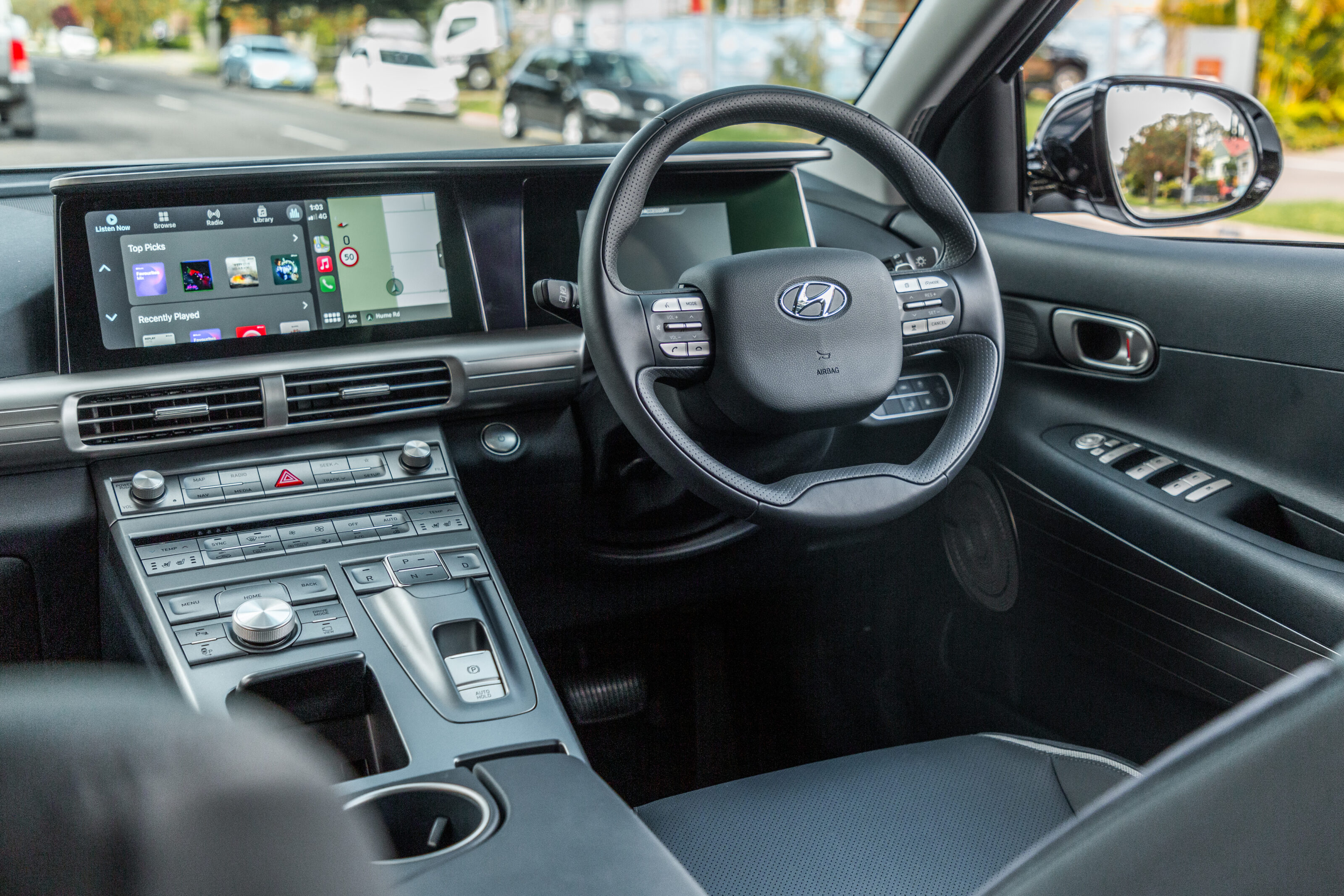
Both have Apple CarPlay and Android Auto connectivity via USB as well as wireless phone charging.
Now, do you recall how I said the Nexo is more expensive than the IONIQ? Well, it is… and it isn’t. At the moment, you can’t buy one if you’re a private customer, because it’s unlikely you have regular and unfettered access to a hydrogen filling station – unless you’re, I dunno, the recently greened-up Twiggy Forrest.
The ACT and Queensland governments both have access to such a thing, the ACT having a dedicated site with the required 10,000psi capable filling.
If you were to buy one in, say, the United Kingdom, you’d be paying £69,000 – or roughly $130,000 at the current exchange rate, which seems to hover around 53p to the dollar.
This is less a battle between two cars in the same segment but more a comparison of what’s to come. This is very much a ‘who dares, wins’ moment in automotive history.
Comfort and space
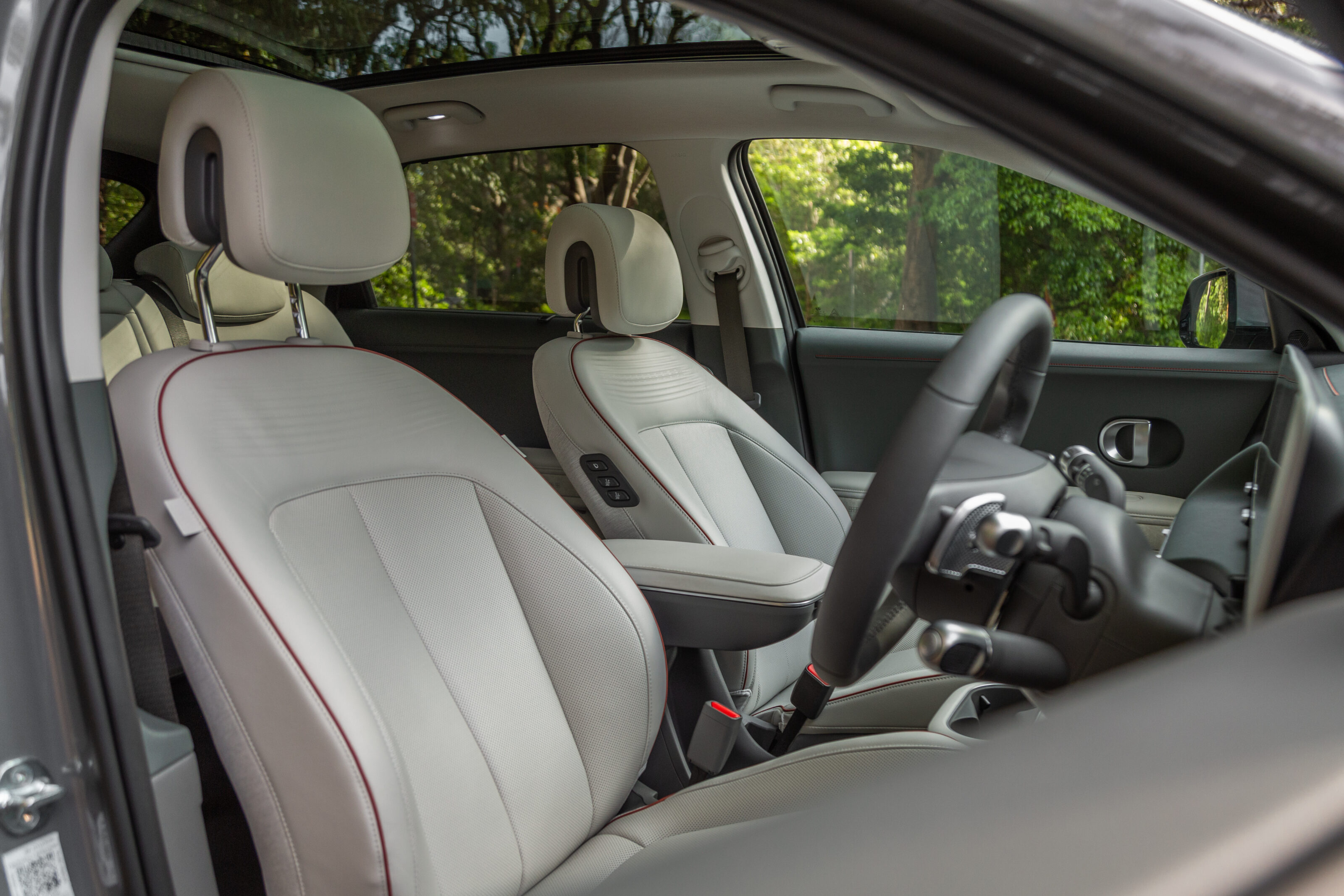
The IONIQ 5 has a wheelbase longer than the giant eight-seater Palisade, but is considerably shorter. Well, I say considerably, but it’s longer than a Tucson while delivering the kind of interior space to make oil tanker jealous.
The front seats are distinctly throne-like and you sit high-ish in the car, which from the outside looks all the world like a Corolla-sized hatchback. Or, more accurately, the Lancia Delta in Integrale spec.
Seemingly an homage to Mercedes, the dash layout is clear and easy to use, although I am not at all enamoured with the gear selector, which is low on the steering column rather than on the non-existent centre console.
Technically, there is a centre console with a huge storage cubby big enough to fit a laptop bag, but it isn’t connected to the dash and it slides fore and aft.
The glove box in the dash easily fits a 13-inch laptop, too. You also get cup holders and bottle holders up front, and a console bin.

The rear seat is shapely and comfortable, and you get an armrest with two cup holders, tons of shoulder room (the 5 is a wide unit) and, unless the front seats are put in ‘zero-gravity’ mode, legroom for days.
The roof does fall slightly with the sunroof fitted, meaning for six-footers, things are a little tight. The flat floor does mean that the middle seat occupant won’t clash feet and legs with the outboard passengers, although they will miss out on the seat heating of the left and right seats.
Adjustable rear air vents are set in the B-pillar closer to face height, which is very handy.
Huge side windows let in a lot of light and with the pale leather of the test car – and the sunroof – it’s bright in there. The rear seats slide back and forward, and you can recline them too, so there’s plenty of adjustability to get comfortable.
Rear seat passengers have two USB-A ports to choose from, set low in the centre console. The front seat passengers also have two USB-A ports.
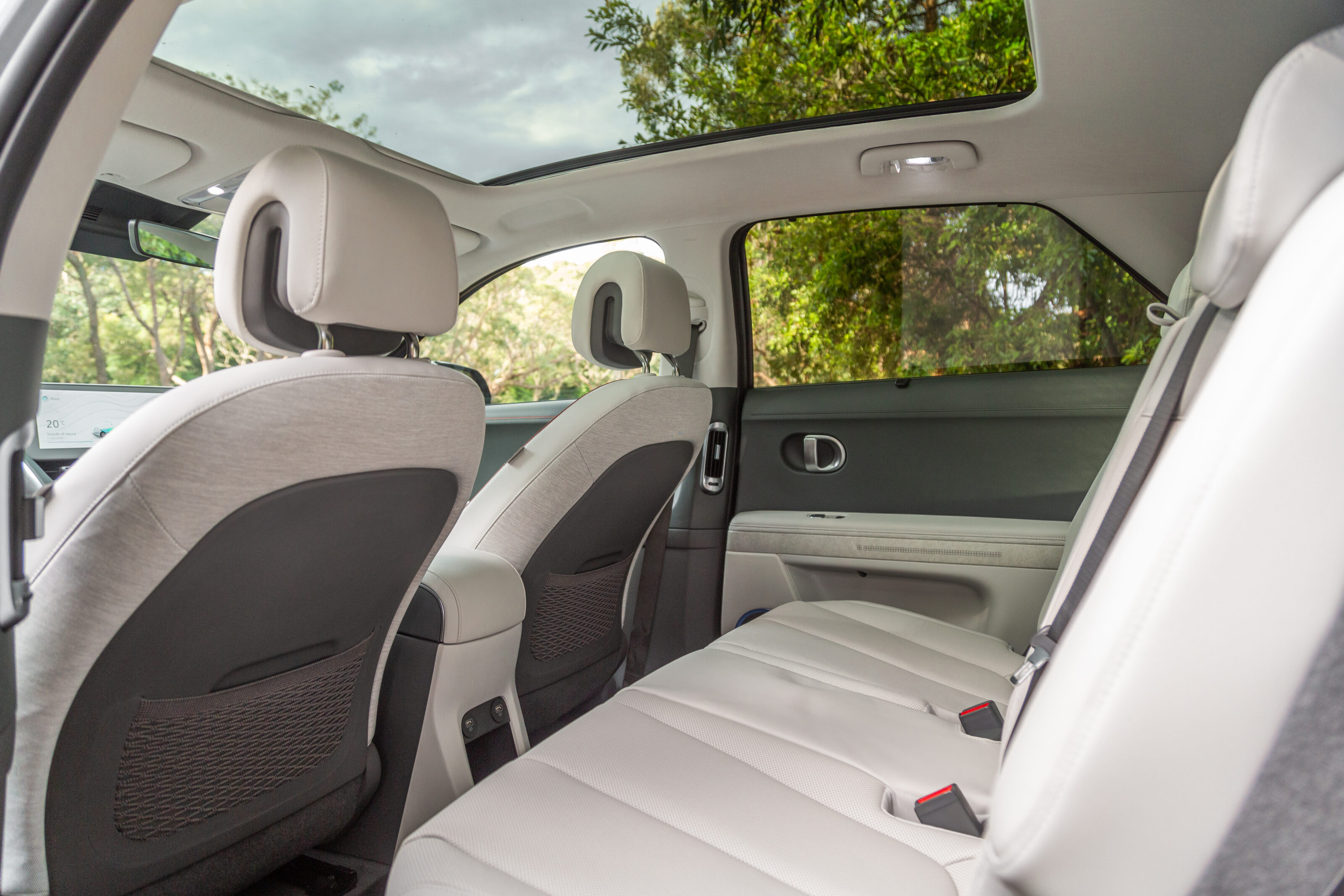
The boot floor is over a metre wide at its narrowest point and with the rear seats in place, just over a metre deep. Floor to ceiling is about 75cm, so you can cram a lot of stuff in here.
Under the boot floor you’ll find the tyre repair kit, charge cables and something really clever – the vehicle-to-load (V2L) adapter. This fits in the charge port to supply up to 3.6kW of power draw to external appliances at up to 16 amps. This means it can even charge other electric cars (slowly), but will stop providing power once your battery falls to 44 percent, or a level you set yourself.
With all that boot acreage, you start with 527 litres no matter which IONIQ you choose. With the seats down, that figure swells to 1587 litres.
It’s worth noting that because of the additional motor up front, the front storage area under the bonnet is less than half the size of the RWD model, with 27 litres playing 57.
The IONIQ 5 looks all the world like a Corolla-sized hatchback. Or, more accurately the Lancia Delta in Integrale spec.
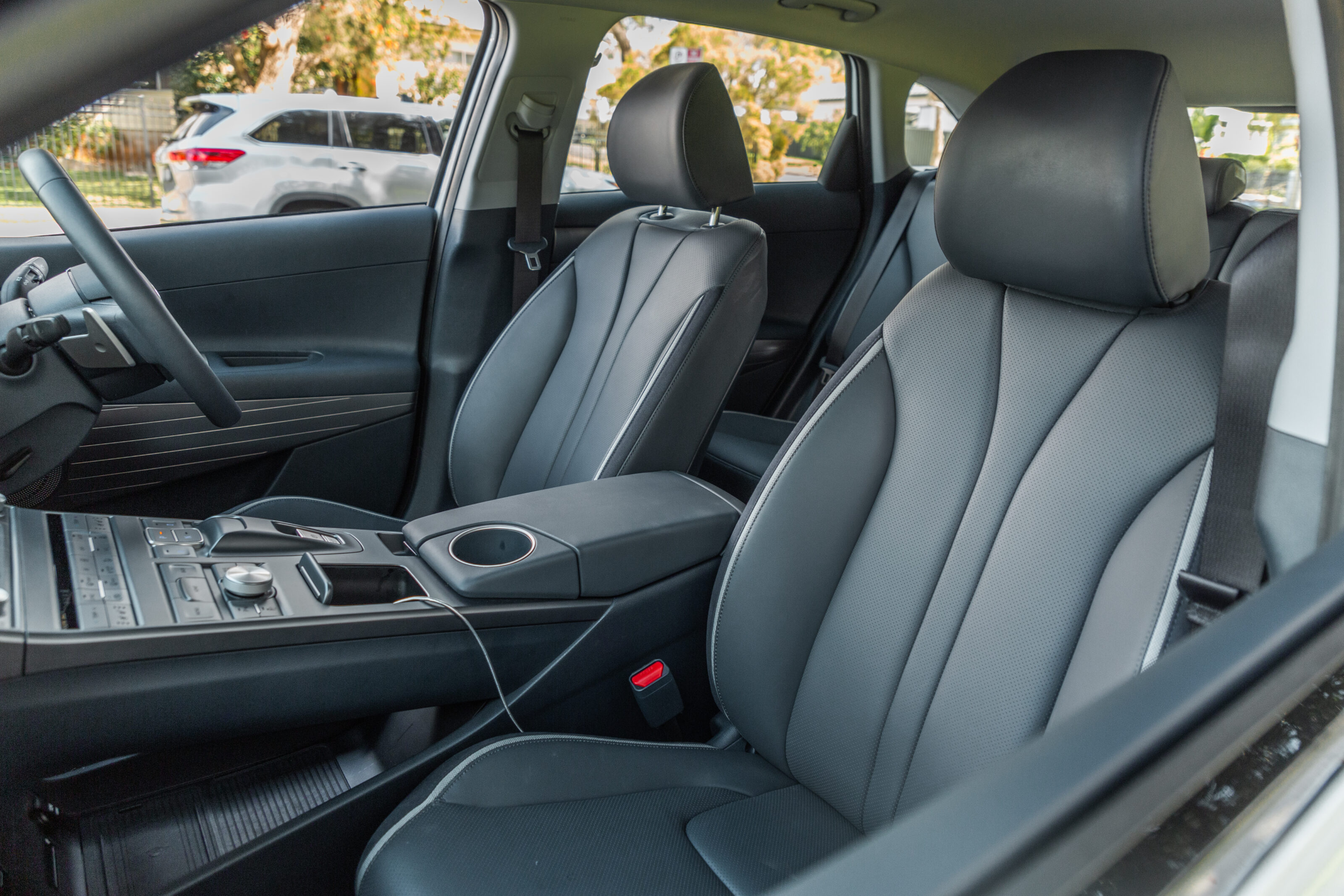
Step into the Nexo’s cabin and you’ll find it’s a bit more conventional, featuring the first appearance of the flying bridge centre console we see in the Palisade and up-spec Santa Fe.
There are many, many buttons in here, almost Porsche levels of buttonage, and more than a few are the same size and shape as their neighbour – so you’ll have a memory game to play when you’re finding a function you want.
Front space feels on par with the Tucson, perhaps slightly bigger, and you have two cup holders in between the seats and bottle holders in the doors.
The console hosts wireless charging and USB ports. Moving to the back and, while the rear space seems a little bigger than in the Tucson, it’s roomy, with more headroom than the lower-slung IONIQ. The floor isn’t quite as flat, though.
The Nexo’s boot is a healthy 461 litres, which isn’t bad given the underfloor battery, and I’d wager a tripling of that with the rear seats down. It’s soundly beaten by the 5’s space, though, and the IONIQ also has a lower loading lip.
Overall, there isn’t a lot in it between the two – they’re different, but deliver roughly the same space, although the IONIQ has a few more inventive touches.
On the road
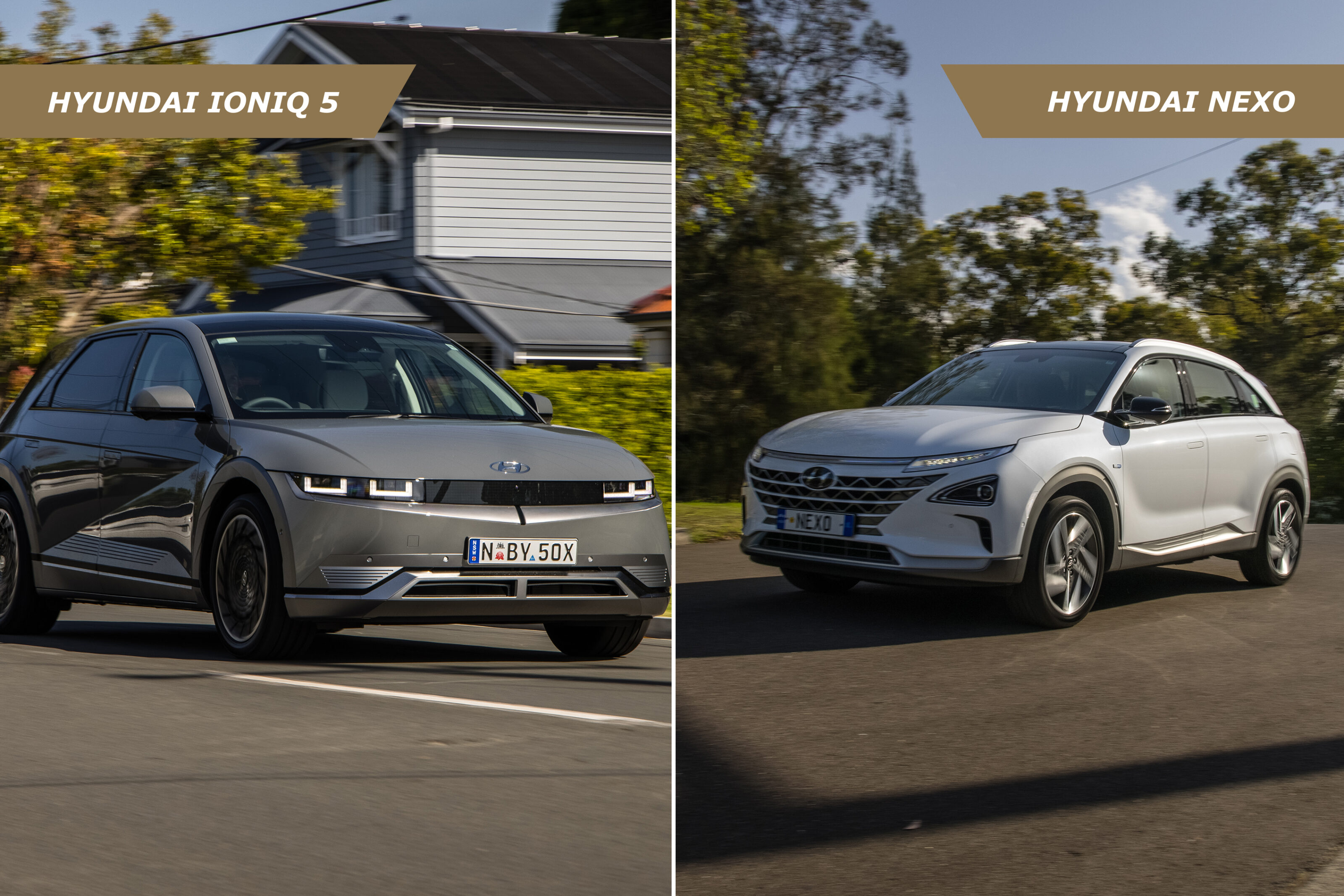
Technology and drive
The two cars share almost nothing in their powertrains, not even the battery. The Nexo’s battery is from the older IONIq Hybrid hatchback, while the 120kW electric motor is from the all-electric version of the IONIQ. (To be clear, I’m referring to the models from this trio, not the newer IONIQ 5.)
Stacked on top of the motor is hydrogen fuel cell paraphernalia, which gets its fuel from three bullet-shaped (and bulletproof) tanks stored around the rear axle.
The Nexo’s multi-link rear end means it gets an extra tank for a total of 156 litres, with 6.3kg of hydrogen stored at 10,000PSI and offering a driving range of 660km. The kerb weight of circa 1800kg significantly undercuts its BEV counterpart.
Filling the Nexo takes just a few minutes, but the catch is that it needs to be a hydrogen filling station – which, as you might imagine, is not a common sight.
To keep the hydrogen safely stored, three layers of carbon fibre and a plastic liner envelop the gas, the walls of the cylinders measuring over ten centimetres.
I’ve held a cross section of the tank in my hand and it’s surprisingly light, but obviously very strong.
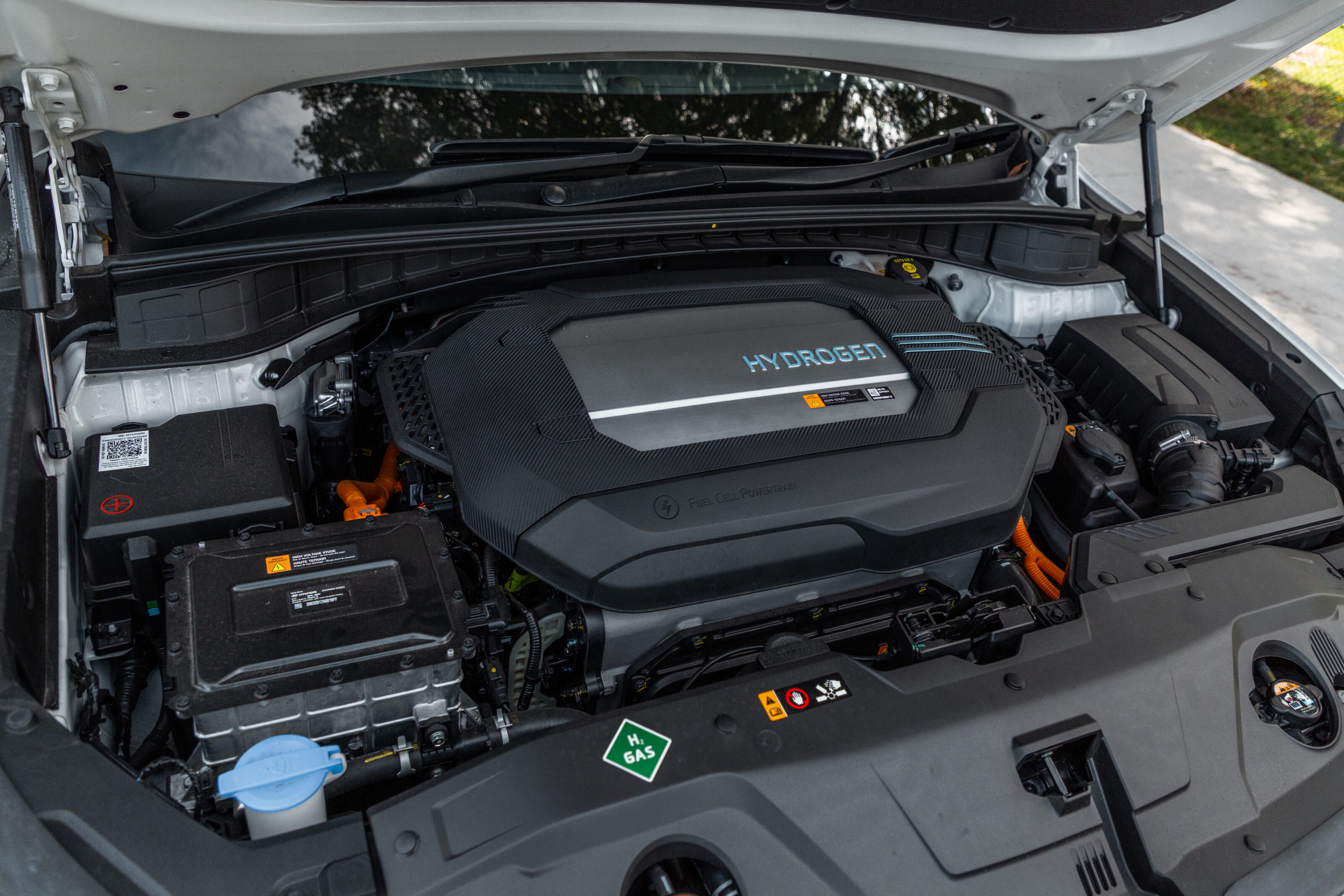
The IONIQ 5 is your classic (in relatively modern terms) skateboard EV platform, with a 72.6kWh battery stored under the floor to power either one motor in rear-wheel-drive form, or two motors for all-wheel drive. A 58kWh price leader is on the way, delivering both a lower price and range.
Depending on your number of driven wheels, the 72.6kWh IONIQ 5 is capable of up to 451km on the WLTP from a single charge.
With both 400 and 800 volt charging available, you can get to eighty percent of charge in just 17 minutes but, like the Nexo’s hydrogen filling station, these super fast-charging options are hard to come by – so you’ll want to keep it plugged in at home or find a fast-ish charger near your favourite cafe/shop/workplace.
They drive very differently, for two important reasons. The Nexo’s loftier format, with the power unit stacked in the front, means it drives like a weighty-nosed front-wheel drive SUV. And, the much lower power outputs mean it’s slower to the 100km/h benchmark than either IONIq.
There is plenty of torque, though, and a greasy surface will get you some wheelspin. While it might be more leisurely off the mark – and the throttle response relies heavily on the small battery as well as hydrogen delivery to the fuel cell – it’s pretty impressive on the freeway. It holds speed nicely and is very quiet while doing it.
Overtaking is a breeze, because the torque really gets the Nexo moving and, given it’s much lighter than the IONIQ 5, the performance gap narrows a little when you’re already moving.
Across the same challenging roads, the IONIQ is firmer but faster. It’s just as quiet, if not quieter than the Nexo.
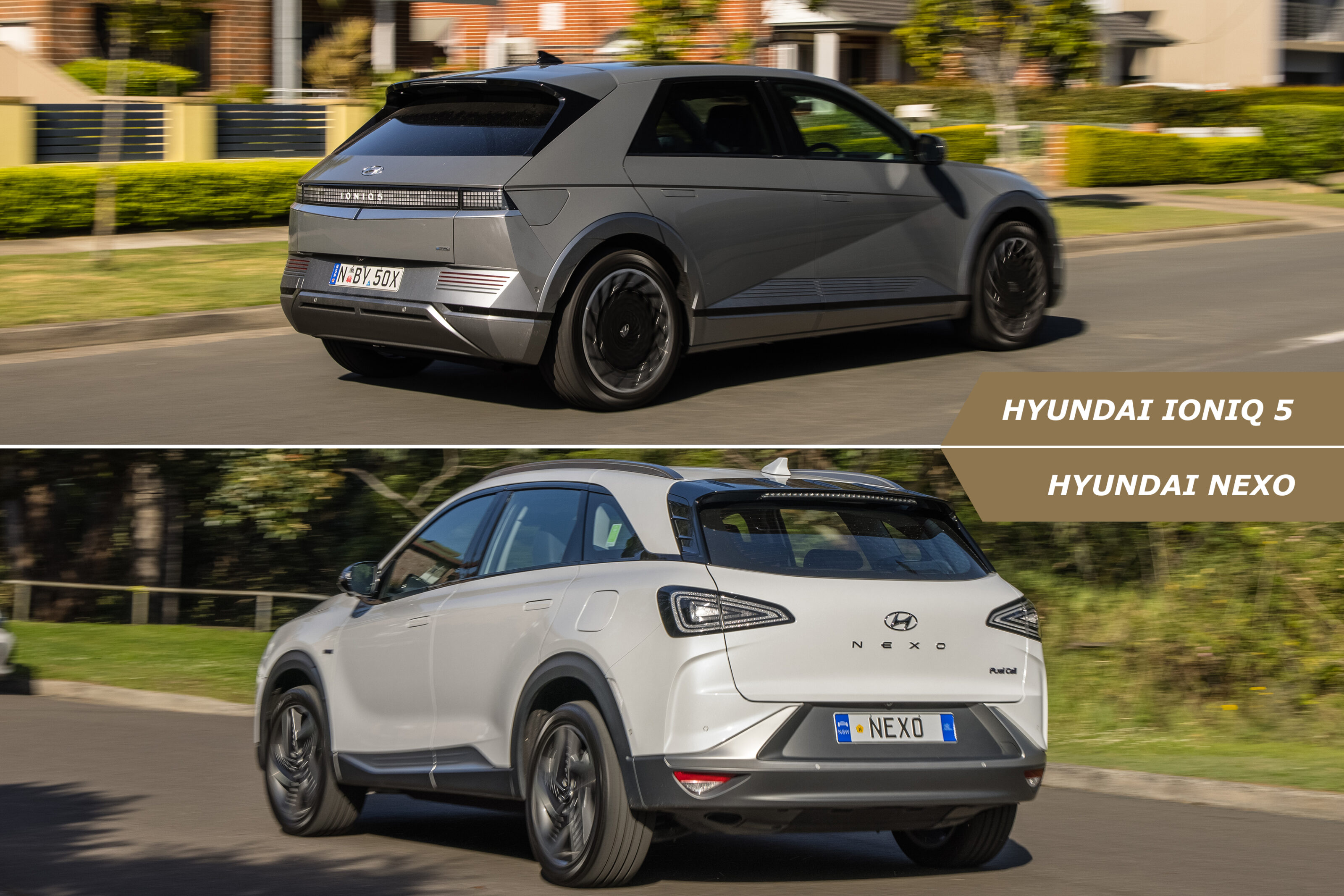
What’s more, the Nexo’s longer springs mean the ride is better resolved (thanks once again to the Australian chassis team) although it’s not as capable in the corners.
It’ll wash wide like a front-wheel drive SUV, but it’s all very benign and easy-going. Too easy-going if you’re in the Eco mode, which is one of two modes. Avoid it if you like driving, but it does make a difference to the range, if only small.
Across the same challenging roads, the IONIQ is firmer but faster, of course. It’s just as quiet, if not quieter than the Nexo, with no puffs and sighs from hydrogen pumps. In either Eco or Normal mode, the dash tells you that you don’t have access to all of the torque (605Nm in the AWD), but when you hit Sport, blimey, it all goes red and the torque bar flips to 100 percent.
Punch it and you get all of the torque, seemingly all at once. Obviously the software ensures it doesn’t pluck out its own driveshafts, but the EV party-trick punch of a flattened throttle (amusingly engraved with a + sign to go, with the – on the brake) and warp-like acceleration is all present and correct.
It doesn’t corner with great vigour, though, and despite the long wheelbase, the ride will get a bit lumpy on occasions. It reminded me a little of the BMW i3’s ride, getting a little weird when things were bumpy – something that was ironed out in the i3 S.
Luckily there’s an N version of the IONIQ 5 coming, so it will be interesting to see what happens there.
It’s a good cruiser, though (which is all we should really expect), and in town not much will touch the AWD off the lights. Or the RWD, for that matter. The power delivery is smooth and strong, and with maximum re-gen turned on (there are three levels to choose from) the IONIQ pulls up nicely. For some reason it took a while to get used to how effective that was – both myself and Mr Spinks found ourselves stopping short.
AND THEN…

The IONIQ 5 is the vastly more modern, “I’m from the future” car compared to the Nexo’s “Oh, look, a mid-sized SUV with a big grille… hey, what’s that blue badge?”
They perform very well, to their obvious intents. Fundamentally, they’re both extremely friendly cars to drive. Both can be super-relaxed and easy-going, are quiet on the fast stuff and have the punch to handle the city.
The Nexo holds its own with its familiar SUV style, while the IONIQ wows the crowds with its breathtaking looks and absolute commitment to the concept with a Minecraft 8-bit aesthetic that leaves you in no doubt that this is something different.
What we’ve learned here is that the Nexo is a properly great car, and I’m okay with a future that includes hydrogen fuel cells. Infrastructure is easy to fix when the will and the want is there, and Hyundai has proven that the fuel is workable and viable, and just like BEV infrastructure.
It’s just a matter of time, should the market go with it – and Hyundai reckons hydrogen will replace diesel.
The IONIQ is even more impressive – a proper ground-up EV to take on the might of the established market leader Tesla. Confident and assured, its very minor flaws will surely disappear before too long. Hyundai is that kind of company.
2022 Hyundai IONIQ 5 vs Hyundai Nexo specifications
| u00a0 | Hyundai IONIQ 5 | Hyundai Nexo |
|---|---|---|
| Body | Five door hatchback | Five-door medium SUV |
| Drive | AWD | FWD |
| Engine | Dual motor electric155kW front, 70kW rear | 95kW hydrogen fuel cell with battery |
| Transmission | Single-speed | |
| Power | 225kW @ 0rpm | 120kW @ 0rpm |
| Torque | 605Nm @ 0rpm | 395Nm @ 0rpm |
| 0-100km/h | 5.2 sec (claimed) | 9 sec (claimed) |
| Fuel consumption | N/A | 23.4L/100km (combined) |
| Weight | 2100kg | 1814kg |
| Suspension | MacPherson strut (front);multi-link (rear) | |
| L/W/h | 4635/1890/1605mm | 4670/1860/1640mm |
| Wheelbase | 3000mm | 2790mm |
| Front brakes | 345mm ventilated disc | 320mm ventilated disc |
| Rear brakes | 345mm ventilated disc | 302mm solid disc |
| Tyres | 255/45 R20 Michelin Pilot Sport EV | 245/45 R19 |
| Wheels | 20-inch alloy wheels ( spare) | 19-inch wheels (no spare) |
| Price | $74,900+ ORC | N/A |
We recommend
-
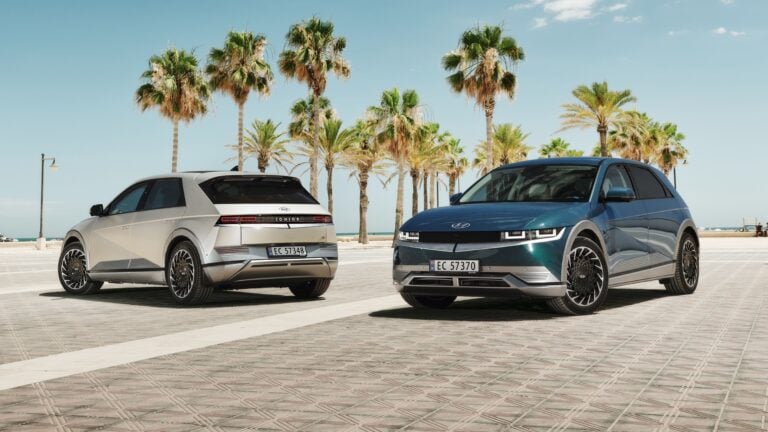 News
News2022 Hyundai Ioniq 5 pricing and features revealed for Australia
Hyundai’s bold new dedicated electric vehicle has landed, but options are limited
-
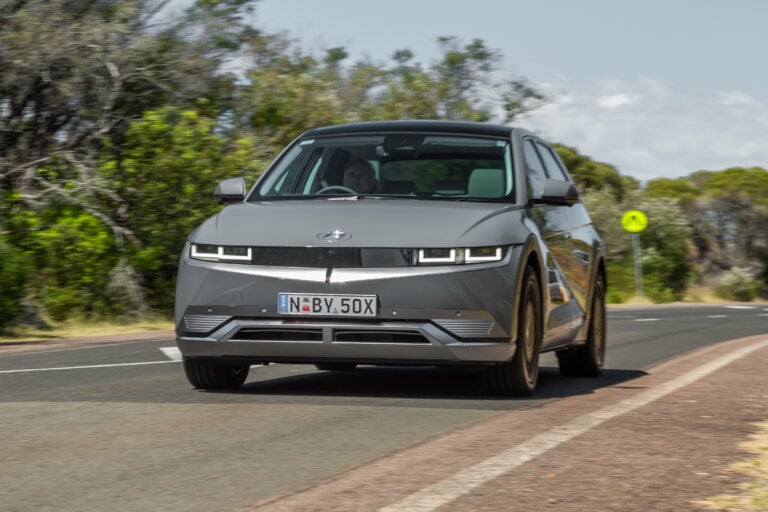 Reviews
Reviews2022 Hyundai IONIQ 5 EV review: Australian first drive
It's the most striking and intriguing car to ever come from Hyundai. We find out if the IONIQ 5 is as brilliant as it looks.
-
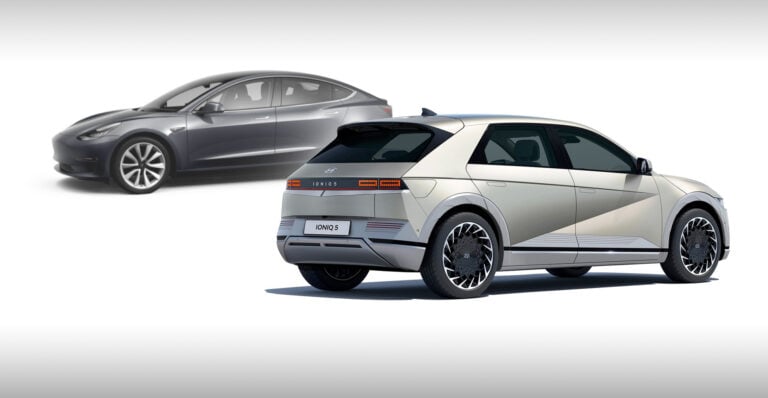 Features
FeaturesHyundai Ioniq 5 v Tesla Model 3: Specs and pricing compared
How does the new contender stack up against the EV king?


